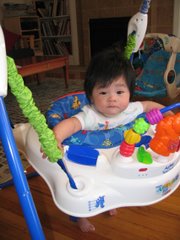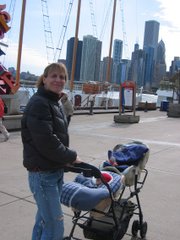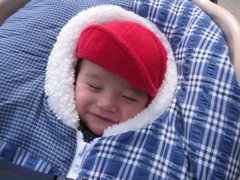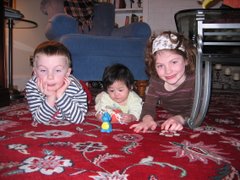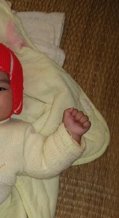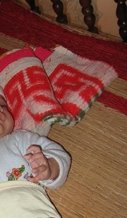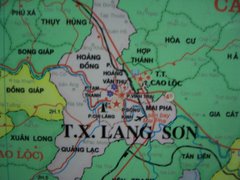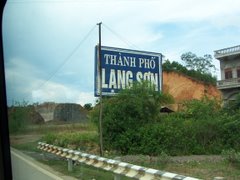 World Child must know that we are all anxious, so when we arrived on Saturday with nothing to do until Thursday, they planned a trip to Sa Pa for us to pass the time. Martin arranged with the hotel for us to take the night train to Lao Cai and then a mini-bus from Lao Cai to Sa Pa, up a switchback mountain road.
World Child must know that we are all anxious, so when we arrived on Saturday with nothing to do until Thursday, they planned a trip to Sa Pa for us to pass the time. Martin arranged with the hotel for us to take the night train to Lao Cai and then a mini-bus from Lao Cai to Sa Pa, up a switchback mountain road.We piled out of our mini-bus in front of the Hanoi train station to a crowd that would rival Grand Central, but it was all out of doors. The noise was deafening, and there must have been 100 Pho sellers squatting by the road side. The honking and screeching taxis and scooters made crossing the road to station a delicate operation. We trekked out to the tracks, walked down the dimly lit walk, peering into the sleeper cars with tiffany lamps, water bottles, flowers on the tables, and two beds adjacent to dark wood walls. But, we just kept walking. The next cars didn't have the wood wall, but they did still have a lamp and this time four beds in the sleeper cars, but we still kept walking.
 Finally, we reached our car. Martin looked shocked and the rest of us tried to take it all in stride. After conferring rapidly in Vietnamese with the train conductor, Martin assigned us to our berths. Marci, her mom Betty and her two kids Robby and Katie shared a room with Lisa and her mom Cindy. Ed, Martin and I were in the room next door. The six berths, about the size of coffins, were stacked and stocked with pillows and blankets. Martin agreed to climb to the top, Ed took the middle and I was on the bottom bunk. Just before the train pulled out, our other three roommates came in and settled into the berths across the spacious aisle. Around 2 am two of our roommates left and two new ones got on.
Finally, we reached our car. Martin looked shocked and the rest of us tried to take it all in stride. After conferring rapidly in Vietnamese with the train conductor, Martin assigned us to our berths. Marci, her mom Betty and her two kids Robby and Katie shared a room with Lisa and her mom Cindy. Ed, Martin and I were in the room next door. The six berths, about the size of coffins, were stacked and stocked with pillows and blankets. Martin agreed to climb to the top, Ed took the middle and I was on the bottom bunk. Just before the train pulled out, our other three roommates came in and settled into the berths across the spacious aisle. Around 2 am two of our roommates left and two new ones got on.As Ed said to Martin, "If this was the Titanic, we'd been in steerage, with the Irish." I'm not sure Martin got the joke, but he was interested in steerage.
I didn't sleep much on the train, and by the time it was day-light, we were approaching Lao Cai. Staring out the window at the neatly terraced rice paddies, tin-roofed wooden huts, I noticed water buffalo precariously near the train windows. They seemed unperturbed by our passing.
 Our mini-bus from Lao Cai swerved and rocked up the mountain to Sa Pa, dropping trekkers and backpackers off along the way. As the last stop, we were hindered by the mountain-top traffic jam, but made it to our hotel, the Green Bamboo, in time for breakfast. We met our guide, Hao, at breakfast and he explained the next two days. We'd visit a Black H'mong village first, then on the next day Giay village.
Our mini-bus from Lao Cai swerved and rocked up the mountain to Sa Pa, dropping trekkers and backpackers off along the way. As the last stop, we were hindered by the mountain-top traffic jam, but made it to our hotel, the Green Bamboo, in time for breakfast. We met our guide, Hao, at breakfast and he explained the next two days. We'd visit a Black H'mong village first, then on the next day Giay village. Hiking down to the H'mong village, we were literally surrounded by H'mong girls, all speaking fabulous English that they learned from tourists, who were trying to sell the traditional H'mong indigo embroidered clothing and bags. Robby and Katie made friends and even exchanged email addresses with the H'mong girls. (Though the girls speak excellent English, and some of them French as well, they don't read and write, so I am not sure how effective the emailing will be).
Hiking down to the H'mong village, we were literally surrounded by H'mong girls, all speaking fabulous English that they learned from tourists, who were trying to sell the traditional H'mong indigo embroidered clothing and bags. Robby and Katie made friends and even exchanged email addresses with the H'mong girls. (Though the girls speak excellent English, and some of them French as well, they don't read and write, so I am not sure how effective the emailing will be).Hao confirmed to us what my suspicion had been all along. The H'mong people had been a much more nomadic group, hunting and growing corn and rice all around the Sa Pa mountains and valleys. More recently, the Vietnamese government has taught them to farm in a single area, and much like the Native American reservation system, the government seems eager to on the one hand protect some aspects of traditional H'mong culture, while on the other assimilating the H'mong into Vietnamese society.
 The children don't attend school regularly. Hao explained that the Vietnamese government has tried to teach the H'mong about family planning, but that does not seem to be working. I felt like an intruder at times, especially when Hao brought us into a H'mong family house, explaining that they would hang green leafs outside if they were praying or didn't want visitors. On the other hand, the H'mong people themselves were hospitable and welcoming.
The children don't attend school regularly. Hao explained that the Vietnamese government has tried to teach the H'mong about family planning, but that does not seem to be working. I felt like an intruder at times, especially when Hao brought us into a H'mong family house, explaining that they would hang green leafs outside if they were praying or didn't want visitors. On the other hand, the H'mong people themselves were hospitable and welcoming.
I do wonder about the issue of cultural integrity, and whether this influx of tourist money is something that will ultimately be problematic. It does seem that the encroachment of the West and a more urban Vietnamese culture is inevitable, and perhaps this mix of government protection along with "improvements" like electricity in the small houses, is the only way to avoid complete cultural annihilation.
 The physical beauty of the place is astonishing, and even though we were there on a rainy and foggy day, the green terraced mountains and the 40 foot bamboo stands seemed to exude a kind of calm.
The physical beauty of the place is astonishing, and even though we were there on a rainy and foggy day, the green terraced mountains and the 40 foot bamboo stands seemed to exude a kind of calm.On the way back up, Betty got a ride on a motor scotter, and our other guide Martin came zooming by on one as well. Ed and I and the others took the long walk back up to our hotel, then made plans for day two.
Ed and I also made it back to the Sa Pa market, where up top you can get all of the textiles made in the villages and down below you can get every kind of food imaginable: rows and rows of whole chickens, buckets of crabs crabs, pails of fish, entire slabs of beef. The smell is of wood smoke mixed with fish and damp. As the early morning shoppers, we were surrounded by H'mong women trying to sell their wares.
 Lucy, a 16 year old H'mong girl, became our translator for the morning. We bought bags, traditional baby carriers, wall hangings, hats and outfits for the babies, and even a stuffed water buffalo. All have the smoky smell of the homes where they are made. We wonder about the indigo dye, but someone told us that we can wash them in vinegar to set it when we get home. We'll have a big pile of things for Elizabeth, Doyle, Griffin, Kate, and Sean to choose from.
Lucy, a 16 year old H'mong girl, became our translator for the morning. We bought bags, traditional baby carriers, wall hangings, hats and outfits for the babies, and even a stuffed water buffalo. All have the smoky smell of the homes where they are made. We wonder about the indigo dye, but someone told us that we can wash them in vinegar to set it when we get home. We'll have a big pile of things for Elizabeth, Doyle, Griffin, Kate, and Sean to choose from.In the Gaiy village, there was clearly a feeling of tourism, since a little store/restaurant had been set up to accommodate the many trekkers.
 Out back, we climbed a bamboo bridge over a river that feeds the rice paddies. Ed spent much of the time in this village talking with Ping, a girl of about 11 or 12 who spoke English, French, and German (as well as Vietnamese and her own dialect). Ping and the other girls didn't quite believe that we were here to adopt babies. We told them we'd come back to visit in a few years.
Out back, we climbed a bamboo bridge over a river that feeds the rice paddies. Ed spent much of the time in this village talking with Ping, a girl of about 11 or 12 who spoke English, French, and German (as well as Vietnamese and her own dialect). Ping and the other girls didn't quite believe that we were here to adopt babies. We told them we'd come back to visit in a few years. Hao told us that in the last five years, much of Sa Pa has been developed with WTO money. We've read that the trend to commercialize in Sa Pa will undoubtedly continue as there are plans for a fancy hotel complex in the works. You can also see the influence of the French, as Sa Pa was once a place filled with French villas. Hao also told us that when the Chinese invaded in 1979, many of the villas were destroyed, but the feeling remains.
Hao told us that in the last five years, much of Sa Pa has been developed with WTO money. We've read that the trend to commercialize in Sa Pa will undoubtedly continue as there are plans for a fancy hotel complex in the works. You can also see the influence of the French, as Sa Pa was once a place filled with French villas. Hao also told us that when the Chinese invaded in 1979, many of the villas were destroyed, but the feeling remains. The last event of our Sa Pa trip was Hao's wedding feast. He'd been married just a few days before, and his wife was one of the cooks at our hotel. So, we joined them for a wedding feast in the hotel restaurant. This was real Vietnamese food, with water bottles of home made rice wine on the table, along with sticky rice, bamboo soup, and a whole roasted chicken, head and all. The vegetables contained the rest of the chicken -- stomach, heart, eggs (and Katie was brave and ate one of the eggs, which looked much like a yolk). It was a good final meal before our trip back down to Lao Cai and the night train back to Hanoi.
The last event of our Sa Pa trip was Hao's wedding feast. He'd been married just a few days before, and his wife was one of the cooks at our hotel. So, we joined them for a wedding feast in the hotel restaurant. This was real Vietnamese food, with water bottles of home made rice wine on the table, along with sticky rice, bamboo soup, and a whole roasted chicken, head and all. The vegetables contained the rest of the chicken -- stomach, heart, eggs (and Katie was brave and ate one of the eggs, which looked much like a yolk). It was a good final meal before our trip back down to Lao Cai and the night train back to Hanoi.We do have to tell you about the mini-bus ride back down the mountain.
When the bus pulled up at our hotel, I thought there was no way all nine of us, with our luggage, were getting on that jammed full bus, but we did -- with much negotiating by Martin and the driver. After what felt like a treacherous u-turn atop the mountain, our bus driver stopped again at another hotel and we groaned collectively. In total, 24 passengers plus the driver and lots of luggage were crammed onto a bus intended to hold no more than half that number.
 We arrived back in Hanoi tired, but excited that Lisa heard -- just as the train was leaving the station -- that she would be meeting her baby the next day. This time, we knew what to expect on the train ride home, or rather to our temporary home in Hanoi. Martin did try to negotiate with the hotel (without our knowledge) for the Tiffany-lamped first class cars, but we all seemed to like the adventurous feel to the "steerage" cars. We are Irish, after all!
We arrived back in Hanoi tired, but excited that Lisa heard -- just as the train was leaving the station -- that she would be meeting her baby the next day. This time, we knew what to expect on the train ride home, or rather to our temporary home in Hanoi. Martin did try to negotiate with the hotel (without our knowledge) for the Tiffany-lamped first class cars, but we all seemed to like the adventurous feel to the "steerage" cars. We are Irish, after all!
